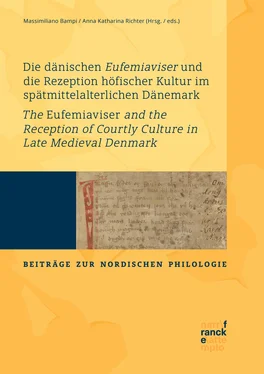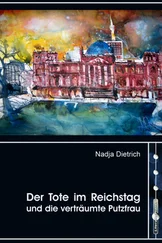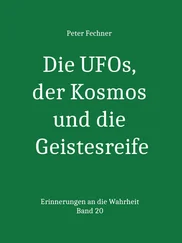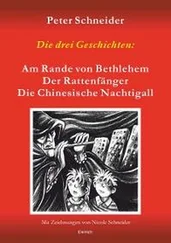Compared to the literature of other European central cultures in the late Middle Ages, the Swedish and Danish romance literature is minute, but what matters here is the fact that there was a certain interest in this kind of literature as part of a more general interest in secular narratives in the latest phase of the medieval manuscript culture. Each manuscript was an expensive economic investment, and obviously there was enough interest to translate and create new texts as well.
The possible connection to religious contexts also deserves some further comments, as it is not self-evident why romances appear in otherwise religious manuscripts. Bampi (2019: 227–230) discusses two such Scandinavian cases, the already mentioned Danish MS K 4Codex Holmiensis K 4 (Stockholm, Kungliga biblioteket) and the Norwegian MS Stockholm, Riksarkivet, E 8822. These manuscripts have similar content structures, namely Ivan løveridder Ivan løveridder (dän.)/ Herr Ivan Ivan lejonriddaren (schwed.) as a single romance text among other religious, edifying texts, and from that pattern and with support from previous research, Bampi argues that the romance could have been open to a religious reading and interpretation. A similar interaction between romance and works of piety has been reported in other parts of Europe, for instance, in English late medieval manuscripts.
The compatibility of romance with piety […] is endorsed by the evidence of manuscripts and readership. The compilers of late medieval miscellanies, increasing numbers of them middle-class townsmen (such as the Leicester burgess Rate or the London mercer Johan Colyns) or gentry (such as the Yorkshire Robert Thorton), generously confirm the tendency in earlier collections […] to mix romances with works of orthodox piety […]. (Cooper 1999: 696–697)
Considering how deeply religious medieval society was, it is not surprising that works of piety are found together with ʻsecularʼ ones in lay manuscripts. However, it is perhaps a little more conspicuous when single ʻsecularʼ narratives are brought into manuscripts with mainly religious texts. In a discussion on the Middle English romance, Adams (1998: 291) argues that surrounding a romance with religious works even could be understood as a neutralisation of the morally problematic character of romance. The traditional genre had been criticised for its amoral themes, and probably as a response to that, Middle English romance tended to be influenced by the genre of Saints’ lives. In several ways there came to be a relationship between romance and the religious genres, and the two Scandinavian manuscripts seem to fit into that picture.
In one important aspect, the situation in Scandinavia differs from Cooper’s description of late medieval England in the quotation above. The reading culture among the lay, urban classes in England has no known counterpart in medieval Scandinavia, as no Scandinavian medieval manuscripts are clearly linked to burghers or townspeople (if we do not count the secular clergy). We must be careful about drawing conclusions e silentio , but as far as the material allows us any conclusions, the romances and secular narratives seem to have been a matter of concern for aristocratic readers, perhaps to some extent in religious settings.18
2 Changing texts, genres, and corpus
Before we move on with the analysis of the early printed book culture in Denmark, it is necessary to consider which texts should be included in the discussion and how the term ʻromanceʼ should be understood and used. It also requires a discussion on the concept of genre.1
The Eufemiavisor Eufemiavisor (schwed.) text group took its departure from the emblematic romance of Yvain Yvain ou le Chevalier au lion , but came to include perhaps less typical romance works of Hertig Fredrik Hertig Fredrik af Normandie (schwed.) and Flores Flores og Blanseflor (dän.) och Blanzeflor . They were, however, shaped in the same form of knittel verse regardless of the character of their original, and an intended convergence is also visible in the translation of Flores och Blanzeflor , which is rewritten in a more courtly direction than the original (Bampi 2018/2019). Even if the three texts originally belonged to different traditions, they merge into a more closely connected group of texts as the Eufemiavisor .
The fifteenth century Danish knightly verse tales are obviously related to the Eufemiavisor Eufemiavisor (schwed.), but they were held in a new, less courtly key, as the analysis of their vocabulary in Akhøj Nielsen (2017) has shown. There seems thus to have been a drift away from some of the typical features of the courtly language and content of the Eufemiavisor . In Sweden, we find no similar extension of the Eufemiavisor romance verse literature, but the literary corpus of secular narratives was expanded with prose works of other traditions, such as Valentine et Orson or the Septem sapientes Septem sapientes .2 The question is thus: are the new texts of the fifteenth century so different from the Eufemiavisor that it is no longer relevant to speak of the same kind of text? Is it a genre that changes or becomes more inclusive, or do the new texts form a new genre of their own?3 Are even the Eufemiavisor to be regarded as one genre? These questions are complex and challenging, and the answers also depend on how we understand the concept of genre.
In a theoretical discussion on genre evolution and emergence, Miller (2016) points out that genre has traditionally been discussed either deductively from normative definitions, such as for instance the different kinds of speeches of Aristotle, or from an inductive analysis of traits in a given group of texts. Both these approaches aim at formulating the essence of a genre: what a genre actually is in terms of textual properties. In the case of romance, there are several such essentialistic definitions, such as the following example: “[a] fictional story in verse or prose that relates improbable adventures of idealized characters in some remote or enchanted setting” (Baldick 2008: 291). The consequence of such a definition is that some of the textual innovations we find in late medieval texts must be seen as an abandonment of the initial genre and the emergence of new genres, or the evolution of new sub-genres. However, such a rigid essentialism has been criticised for being anachronistic and not taking the contemporary views among the audience of the Middle Ages into consideration.4 Would the late medieval readers agree upon the same definitions that we apply?
Miller has shown a way from such essentialism in her seminal article “Genre as social action” (1984), further developed in the discussion in Miller (2016), in which genre is treated as a social category. Genre is then not defined by specific traits in a group of texts but is instead based on habits and opinions among speakers, writers and readers. This leads to an interest in, for instance, how genres are named by their users (2016: 13). In the Scandinavian medieval context, where there is a shortage, or even an absence, of any meta-discussion about and literary terminology for vernacular texts, one might instead trace ideas about genres with respect to how texts were arranged in multi-text manuscripts.5
This social approach makes the concept of genre a dependent variable rather than an independent one, thus not postulating the existence of a genre but rather exploring genre as a possible, socially construed way of communication among the users and producers of text within a textual culture. This also means that it is necessary to be open to changing textual properties within the same genre in a growing corpus of texts.6 As long as texts are treated as a certain genre by their users, this is enough reason to speak of it as such, even if originally typical genre traits are replaced by innovations. However, if texts start to be read and used and categorised in new ways, one would have reasons to argue that a genre change is occurring. The religious reading of classical romance texts, which we touched upon in the last part, would then represent a possible genre change even if the texts themselves did not change at all.
Читать дальше












